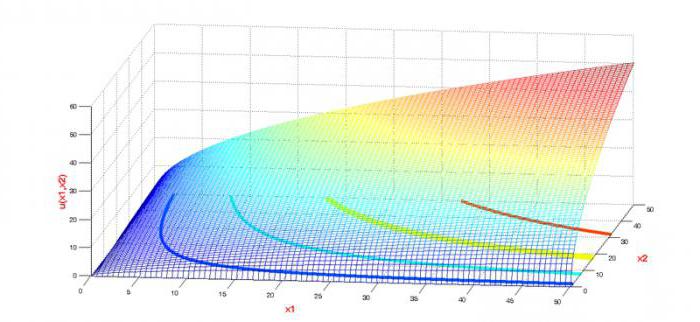Business owners and top managers of enterprises solve a wide range of problems. But among the key ones is ensuring the profitability and competitiveness of production. Its successful solution can be predetermined by a variety of factors. It is extremely important not only to identify them, but also to properly analyze and examine their significance from the point of view of the impact on the efficiency of the output of goods. Tools that can be used by company owners or managers can be based on a wide range of solutions and approaches. Among the most affordable and simplest is the Cobb-Douglas function. Many analysts use it, primarily because of its versatility - its structure allows you to adapt calculations to a wide variety of types of economic processes. However, the practical use of this function is traditionally associated with the analysis of just the same production part of the business model. What are the specifics of the corresponding economic instrument? What tasks is it best suited for?

What is a production function?
Before talking about what the Cobb-Douglas function is, we will determine the essence of the term in question. What are common points of view regarding this phenomenon?
Under the production function, modern researchers understand the relationship that is established between the factors of production, as well as the maximum possible indicator of the volume of the product that is produced due to the influence of relevant factors. Analysts believe that its main property is concreteness. That is, a single function should correlate with a specific technology. As soon as other solutions appear, then production function developed for them separately.
The practical significance of the indicator in question may consist in determining the minimum amount of costs that is necessary for the release of goods in the required quantity. The main properties of production functions:
- an increase in indicators of the volume of output of goods, depending on the use of one and the same resource, cannot be unlimited;
- factors of production in some cases can be mutually supplemented or replaced.

The structure of production functions is most often represented by the following main components: the volume of goods produced, the amount of capital, the volume of raw materials, the specifics of the technology used, the quality of management and decision making.
Why are production functions involved?
The use of production functions is associated with the need to optimize relevant business processes. An enterprise, releasing goods, expends certain resources. Most often it is labor and capital. Actually, these become key factors of production and form the basis of the structure of the function in question. A significant indicator can also be fixed assets of the company, which are used to release goods. In some cases, the function in question can be adapted to calculate parameters that are also associated with funds. The company's management, using the economic instrument in question, gets the opportunity, first of all, to optimize the volume of investment in production by virtue of possession of data on what the required volume of certain resources should be in order to achieve the desired output of goods.
The Cobb-Douglas function is one of the simplest in structure. We study its specifics in more detail.
Features of the Cobb-Douglas Function
The Cobb-Douglas function involves calculating the required indicators based on an analysis of the relationship between labor and capital as the main factors determining the productivity of production. They are considered interchangeable as well as complementary. The feature in question was developed by American researchers Charles Cobb and Paul Douglas. It can also be used as a macroeconomic model.

The production function of the Cobb-Douglas has the form, in the structure of which there are such components as:
- production coefficient, which reflects the proportionality of functions and is adjusted during changes at the level of basic technology;
- capital and labor indicators;
- elasticity factors related to the volume of output of goods in correlation with investment of capital and labor.
The involvement of the function in question can be expressed in the analysis of elasticity coefficients. The result of this may be the allocation of a function that will:
- grow in proportion
- increase disproportionately
- decrease.
It will be useful to draw attention to a number of patterns that the Cobb-Douglas function allows to identify. Among them is the law of diminishing returns.
Law of diminishing returns
Its peculiarity is that it operates for a relatively short period, and also provided that the basic production factor does not change - just like the production technology. If, for example, the process of releasing goods is modernized in one way or another, then the volume indicators for the output of goods may increase with the remaining values correlating with production factors. If the amount of capital is constant, and the volume of labor changes, then the company can make the output of the goods more intense by leveraging more of the second type of resource.
However, by virtue of the law in question, the degree of impact of this increase on practical performance will decrease as its volume grows. For example, if you hire not 10 people to the television production workshop, but 30, then this will not mean at all that the output of equipment will triple. Most likely, at a certain stage of hiring new employees, the profitability of production will begin to decline.
Marginal Product Dynamics
Considering the various parameters of the Cobb-Douglas production function, one can also pay attention to such an indicator as the dynamics of the marginal product. Its calculation can be based on the law noted above. The dynamics of the marginal product involves the allocation of indicators such as total, average, and also the ultimate product itself. Moreover, each of them can also be fixed in dynamics.
As for the overall product, the adjustment of values that correlate with it can be carried out in 3 stages. At the first, there can be an increase in product margin - until the law that we have considered above enters into force. However, as long as the marginal product remains positive, the total will also increase. But at stage 3, the corresponding limit can become negative. As a result, the dynamics of the overall product will be less intense.
Economies of scale
Another notable phenomenon associated with the Cobb-Douglas function is the economies of scale. What is its feature? First of all, we note that it can also be expressed in 3 versions.
The first assumes that during the calculations a positive effect of the corresponding type will be recorded, that is, indicating that an increase in the production volume of a particular product is characterized by a decrease in average costs.The second scenario assumes that during the analysis a negative effect will be recorded. He suggests that the increase in production will be proportionally insufficiently intense compared with the increase average costs. Factors that determine the occurrence of such a situation may be different. For example, the lack of efficiency in making managerial decisions in the company. There is a neutral economies of scale, in which changes in output indicators will not be accompanied by significant fluctuations in terms of costs.
Utility function
What are the kinds of Cobb-Douglas functions? In the research environment there are no unified approaches to their classification. However, many analysts identify individual varieties of the function in question, based on the areas of its practical application. So, for example, there is a Cobb-Douglas utility function. In practice, its involvement may be associated with the determination of consumer preferences. Thus, we can trace an example of the universality of the function in question. It can be used not only for calculations related to production.
The Cobb-Douglas function, an example of which we examined above, that is, associated with the analysis of consumer preferences, can also be divided into a number of additional varieties, depending on the analysis of a particular market segment.
Features of the application of the function
We will study some notable features of the practical application of the function in question. One of the options for its involvement is the determination of average indicators of labor productivity. This parameter is defined as the ratio between the volume of the released product to the number of labor resources used in the course of its production.
The next significant indicator that can be fixed using the function in question is the average return on assets. It is calculated as the ratio between the indicators of the volume of goods released and the value of production assets. If we use the Cobb-Douglas function, solving problems of the corresponding type may have some peculiarities. So, if we talk about average labor productivity, then according to the Cobb-Douglas function, this indicator will be decreasing. With an increase in investment in labor resources, the noted indicator decreases. And this is quite logical - if the newly hired employees are not provided with the necessary volumes of industrial equipment, then the overall efficiency of their work will decrease.

In a number of cases, for a researcher, such a parameter as marginal labor productivity is important. If the Cobb-Douglas model of the production function is involved in its determination, then the corresponding parameter will be proportional to the previous indicator, and in some cases, be inferior to it in dynamics. A similar pattern is also characteristic of calculating the average and marginal indicators of capital productivity. Another significant production characteristic process - capital-labor ratio. It reflects the amount of funds that falls on one employee of the company.
Product elasticity by work
The most important criterion in the analysis of production is the elasticity of products by labor resources. If the Cobb-Douglas function is activated, the problem in question can be successfully solved. The elasticity in question involves the determination of the ratio of marginal indicators of labor productivity to average. What is the practical significance of this indicator?
The fact is that the elasticity of products allows you to determine the amount of labor required to increase the volume of output by a given amount. Along with the indicator under consideration, such demand as the elasticity of products by the funds involved is in demand.This parameter, in turn, is able to help the management of the enterprise determine what the volume of funds should be in order to achieve the desired production indicators.
In order to determine the elasticity in question, the Cobb-Douglas production function will also be sufficient. In this sense, the economic instrument in question once again proves its universality.
Summary
So, we studied what the Cobb-Douglas production function is. The description of this tool can be presented in the form of a fairly simple structure. This is due to the fact that the function under consideration involves calculations taking into account two factors - the volume of capital and labor.

However, the practical applicability of this economic instrument can be much broader than, for example, production analysis. Above, we studied an example of involving the Cobb-Douglas function in the analysis of consumer preferences. If we consider the areas in which the function in question is most often used, then we can probably single out personnel management.
We also noted above that such a parameter as the elasticity of the Cobb-Douglas function in the corresponding varieties is quite capable of determining. In many enterprises, this indicator is considered one of the key when analyzing the effectiveness of a business model.

We determined which Cobb-Douglas function has the form and which main components are included in it. These are mainly rational indicators, for example, reflecting the volume of investment. Those that in some cases are difficult to express in specific figures - for example, the effectiveness of company management, are not involved. Some analysts, working with production functions, prefer to consider the second parameter on the basis of conditional indicators or exclude it from the calculations altogether, if this allows the specifics of a particular study.
